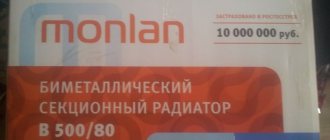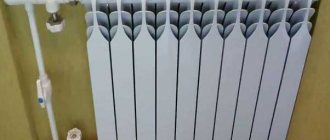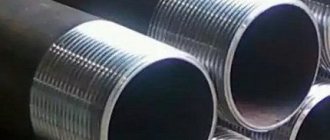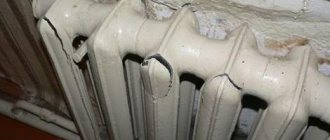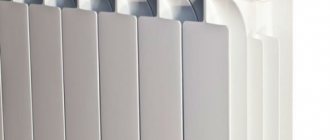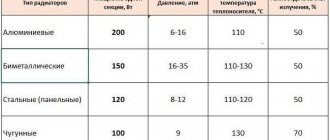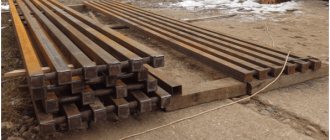These devices look modern and are inexpensive. When properly installed and used, they are capable of performing their functions for a long time. In order to fully use all potential possibilities, it is necessary to accurately calculate the power of an aluminum radiator, which will be required for high-quality heating of a home in the most difficult weather conditions.
Design and technical features
High-quality products from this metal are created using casting. This makes it possible to produce solid, durable heating devices that do not have individual elements or their connections. This technology is quite complex. To eliminate the appearance of defects, strict adherence to many production regimes and control of the absence of hidden defects and cavities is required. The cost of such radiators is slightly higher than prefabricated models. But they are the ones that can withstand without damage a large increase in pressure in the coolant supply lines.
The second common technique is based on extrusion. Metal under pressure fills a special mold. The workpiece is cut into pieces. The connection of individual elements is made by welding. In this case, relatively inexpensive production processes are used. But it should be borne in mind that the finished products are less durable and reliable compared to the first option.
Aluminum radiators of the required size are created from separate blocks so that the final power is sufficient for a specific room. Below are the ranges of values of the main characteristics of devices of this type:
- Permissible maximum pressure in the heating system: from 6 to 24 atm.
- Coolant temperature (max.): up to + 110°C.
- Service life of the heating device: from 10 to 20 years.
Parameters of one section:
- power – from 0.08 to 0.210 kW;
- coolant volume – from 0.2 to 0.5 l;
- weight – from 0.9 to 1.5 kg.
How many sections of aluminum radiator are needed to heat one room?
The simplest and, therefore, not accurate calculation can be made using the following proportion: for each square meter of room, a thermal power of at least 0.1 kW is required.
To find out how many sections you will need, follow these steps:
- For heating one room of 30 square meters. power required is 3 kW: 30*1=3.
- If the power of a single element is 0.15 kW, then 20 sections will be needed: 3/0.15=20.
- This amount is too large for one radiator, so it will be necessary to create and install two radiators in the room. Each of them will be composed of 10 sections.
A more accurate result can be obtained by taking into account the following factors:
- climatic conditions in the area;
- ceiling height;
- the number of window and door openings in the room, external walls;
- presence of heated floors below and above;
- general insulation characteristics of the structure.
Correction factors are used for each of the parameters. Their meanings can be found in professional reference books. Substituting them into the general formula, it will not be difficult to find out what power is required in kW of the section and the device as a whole for a certain room. If the result is not an exact figure, rounding should be done upward. It is easier to make corrections when setting up equipment correctly if it was purchased with a certain margin of capabilities.
How to properly install and operate aluminum radiators more profitably
The main advantages of devices of this type are not difficult to understand from the above data.
However, we list them separately:
- The prefabricated design allows you to quite accurately select the number of elements so that the heating power is sufficient.
- Low weight facilitates transport and installation operations. It does not create unnecessary loads on the fastenings or the building structure.
- Small internal volumes and excellent thermal conductivity reduce inertia. This means that it is permissible to use such devices together with individual regulators, as well as to integrate them into modern systems for automated maintenance of comfortable temperature conditions. Such equipment will reduce the cost of energy resources during operation.
- The neutral appearance of most models fits well with a variety of designs.
- The low cost of the devices allows you to create new or upgrade old heating systems without high costs.
Technical specifications
When considering the design features of aluminum batteries, you need to consider:
- Center-to-center distance, which indicates the difference between the upper and lower collectors. For example, the power of aluminum heating radiators with a center distance of 500 mm is 183-190 W, which makes them the most attractive in the eyes of consumers, while a similar product with an indicator of 350 mm is only 139 W.
- The number of sections in a finished radiator may differ in different models, but most often manufacturers produce products equipped with ten elements.
- The manufacturing method of the aluminum radiator is also important. For example, cast sectional versions are in great demand due to their durability, and can even be installed in houses with central heating. Radiators made by extrusion are only suitable for autonomous heating, since their parts are connected by soldering, which is not as reliable as casting.
- It is important to consider what temperature aluminum radiators can withstand. As a rule, manufacturers most often indicate +90, and in some models even +110 - 120 degrees, while heating in the system itself rarely exceeds +70. This means that the power indicated by the manufacturer in the data sheet does not correspond to reality.
Each of the listed parameters is important in order to make correct calculations of their power and set the required number of sections.
How many kilowatts are in one section of a bimetallic radiator
Bimetallic radiators are difficult to distinguish from aluminum ones in appearance. They can also be equipped with air cutoffs, and the level of heat transfer mainly depends on the height.
As with aluminum, manufacturers' specifications differ from those in reality. Accordingly, in order to unambiguously answer the question of how many kW are in 1 section of a bimetallic radiator, you need to know all the conditions. Therefore, we provide information for the water temperature in the circuit of 65-70 degrees.
Thermal power of a section of a bimetallic heating radiator without air cutoffs:
- 200 mm – 0.5-0.6 kW;
- 350 mm – 0.1-0.11 kW;
- 500 mm – 0.14-0.155 kW.
How many kW of one section of a bimetallic radiator with air cutoffs:
- 200 mm – 0.6-0.7 kW;
- 350 mm – 0.115-0.125 kW;
- 500 mm – 0.17-0.19 kW.
Heat transfer of aluminum radiators: declared and real
Many years of experience in using aluminum batteries have shown that the parameters stated in product data sheets do not match the real numbers. This does not mean that manufacturers are lying, they just do not mention that these indicators are valid under ideal operating conditions, which, as a rule, does not happen in life.
For example, the heat transfer of aluminum radiators, which is indicated in the documents, may correspond to the truth if there is a difference of 70 degrees between the temperature of the air and the coolant. That is, the formula by which these parameters are calculated is as follows:
(treturn + tsupply): 2 – tair = 70 degrees
If the data sheet indicates the power of an aluminum radiator of 200 W at a temperature difference of 70 °C, then at room temperature +22 °C the calculations will be as follows:
(treturn +tfeed) = (22 + 70)x2 = +184 degrees.
Since according to GOST the difference in temperature in the supply and return should not exceed 20 degrees, their value can be calculated as follows:
The coolant temperature in the supply pipe is 184:2 +10 = 102 degrees.
In the return pipe it will correspond to 184:2 – 10 = 82 °C.
Based on these calculations, the aluminum radiator section will produce 200 W of heat, and the air in the room will warm up to +22 only if the coolant temperature is 102 degrees. This is unrealistic, since the maximum heating that modern boilers provide is 80-90 degrees, which means that the power of 200 W indicated in the data sheet does not correspond to the truth.
Design and operating principle
Aluminum batteries can be solid or sectional. For strength and corrosion resistance, silicon, zinc, and titanium are added to aluminum during the manufacturing process.
The sections are connected by threaded connecting elements. The connections are sealed with silicone gaskets. To prevent ruptures, the inside of the radiators is coated with polymer materials.
What should you consider when performing power calculations?
Carrying out calculations regarding the power of heating batteries is an important matter that requires attention to detail. For example, it is not enough to calculate what heat output a heater must have in order to heat the room over its entire area. In this matter, you need to take into account factors such as:
- Method of connecting the battery to the heating network. If it is connected in a cross way, then the heat loss will be only 2%, while with the lower one they will increase to 13%, and with a single-pipe heating system - up to 20%.
- The region of residence should be taken into account, taking into account the period of the lowest temperatures of the year.
- Calculation of aluminum radiator sections based on heat loss is not possible without determining the quality of the building’s thermal insulation. If we take a private house as an example, we will have to take into account the following indicators in the calculations:
- The presence of a chimney “eats” 10% of the heat.
- Roofing brings losses by 20%.
- Non-insulated walls and windows - 30% each.
- The basement will take 10% of the heat.
Such losses can be reduced if you insulate the walls, make high-quality glazing and install heating in the attic and basement.
- If the window in the room faces north, then when calculating the power of the radiator and the number of its sections, you need to add 10% to the result.
- The location of the radiator or the use of the screen also affects the performance.
- You need to know exactly how much heating area is heated by one section of an aluminum radiator. This data can be obtained from the product data sheet.
Only by taking into account all the nuances can you make truly correct calculations of battery power. If some parameters are difficult to determine, then you should add 20-30% to the result and install a thermostat, which definitely won’t be superfluous.
Calculator for selecting steel radiators

The most important condition for creating a comfortable environment in housing is a well-designed heating system. For this reason, the calculation of radiators is considered the first and main stage in planning its installation. And, although there are more than a dozen heating systems of various configurations on the market today, steel radiators remain the leader. At first glance, everything is simple - they are mounted under the windows and heat the air. In fact, there are many technical nuances.
To avoid overheating of the room or, on the contrary, its insufficient heating, you should take into account: the heat transfer of radiators and their number must correspond to the area of the room and other specific criteria. Not only a beginner, but also an experienced builder will not immediately accurately carry out all the necessary calculations. Using an online calculator, you can calculate in a matter of seconds the required number of batteries, as well as their preferred parameters, based on the characteristics of the heated room.
The coefficient method is used as the basis for automatic calculations. Reference, pre-made calculations are taken into account, changing depending on changes made by the user. When issuing results, the following parameters are taken into account:
- heat loss of the room;
- window width, height from window sill to floor;
- coolant supply temperature;
- initial air temperature.
You just have to enter the data requested by the site - and you will receive information based on which you can choose the most suitable radiator: the number of sections, the heat generated by the entire radiator and each section separately. Correct calculation allows you to save money and minimize errors during installation of the heating system.
How to choose a radiator based on the data received
For each radiator, its thermal power is indicated on the packaging or in the attached insert. This indicator indicates the amount of thermal energy that the device produces. You can check it with your sales consultant or simply find it on the Internet for a specific model.
- A heating system with an average rating of 1300 W is considered optimal for moderately cold winters.
- To be on the safe side in case the winter is abnormally cold, it is recommended to increase this figure by 20%. Thus, it turns out to be 1560 W. There are no such batteries on sale, so the figure can be rounded up to 1500 W.
- If the standard power of one fin of a steel radiator is 150 W, 10 fins will be needed. The same rule applies to traditional cast iron batteries.
If there is a major overhaul and you need to install a heating system for the entire apartment, you need to calculate the characteristics and number of radiator sections for each room separately. For example, if the room is corner, with large windows and thin walls, about 47 watts will be needed per 1 m². When calculating a “warm room” that faces south, 30 W/m² will be enough for a comfortable microclimate in cold weather.
Calculation of heating radiator power
A calculator for selecting steel radiators is a simple, but not the only way to plan a heating system. To make sure that all calculations are made correctly, you can use an additional method and determine the required battery power.
For example, if previously standard cast iron radiators 60 cm high were installed in the room, and in winter they were quite enough for heating, count their number and multiply by 150 W. This way you will get the necessary power from new steel batteries.
In rooms where the ceiling height is standard (2.7 m), you can calculate heat transfer rates in another way (otherwise it is better to return to the calculator and determine the required number of sections). It is generally accepted that in regions with an average climate, 1002 W/m is sufficient to create normal conditions in the cold season. Thus, you need to multiply the total area of the room by 100.
How to increase efficiency?
If the batteries have already been installed and have not met their owner’s expectations for high-quality heat, steps can be taken to increase their power.
- You can start by cleaning. Few people know that ordinary dust reduces the heat transfer of a structure by up to 20-25%.
- If this was not enough, you need to invite plumbers to clean the inside of the aluminum radiators.
- You can increase the heat transfer of an aluminum radiator by as much as 15% by painting it dark.
- Installing a heat reflective screen behind a radiator will direct heat into the room rather than heating up the wall. It is better to buy a ready-made model, but you can also use regular foil or a metal sheet. The latter is most preferable, since it will not only reflect the heat, but also, having heated itself, will share it with others.
- You can increase the area of aluminum radiators by making casings from the same metal. When they heat up, they will give off heat for a long time, even if the heating is temporarily turned off.
- Increasing the sections in the battery also helps to increase its power.
If you use at least one of these options, the efficiency of the heaters will increase by at least 10%, while reducing energy costs.
Heat transfer is the most important indicator that needs to be taken into account when installing aluminum radiators. By correctly calculating and taking into account all the factors that influence it, you can create a microclimate in the room that will not only be pleasant to people, but will also have a positive effect on their health.
How to adjust preliminary indicators
Approximate values definitely need clarification. To obtain a more accurate result, you will need to take into account all factors.
Each of them can provoke an increase or decrease in heat loss:
- Material for walls.
- Thermal insulation efficiency.
- Area of window units and type of glazing.
- Number of external walls.
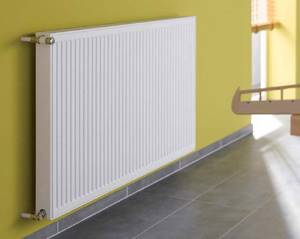
High-quality calculators are equipped with special coefficients that take these factors into account. All that is required to more accurately align the preliminary heat loss indicators is to multiply them by these coefficients.
Most often, it is these structural elements that become the culprits of leakage from 14 to 30% of heat. For a more accurate calculation, you need to take into account their size and level of insulation. This explains the presence of two calculated coefficients.
Ratio of window area to floor area:
The last number is the coefficient.
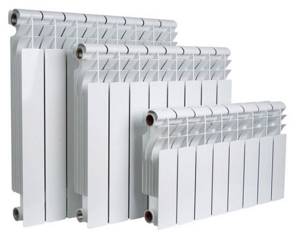
- Three-chamber - 0.85.
- Double-chamber - 1.0.
- Wooden double frames - 1.27 or 1.3.
When considering walls and roofing, the type of material and insulation is taken into account: therefore, there are also two coefficients.
- A brick wall of normal thickness is used as a basis. The coefficient is equal to one.
- For small thicknesses, the coefficient is taken as 1.27.
- Well-insulated structures with a thermal insulation thickness of at least 10 cm: correction number 0.8.
Calculation by area
This is the simplest option for determining a more or less exact amount of heat required for heating. When calculating, the main starting point is the area of the apartment or house where heating is organized.
The area of each room is available in the apartment plan, and to calculate specific values for heat consumption, SNiP comes to the rescue:
- For the average climate zone, the norm for a residential premises is defined as 70-100 W/1 m2.
- If the temperature in the region drops below -60 degrees, the heating level of each 1 m2 must be increased to 150-220 W.
To calculate panel heating radiators by area, in addition to the given standards, you can use a calculator. The power of each heating device must be taken into account. It is better not to allow significant overexpenditures, because... As the resulting power increases, the number of batteries in the system also increases. In the case of central heating, such situations are not critical: there, each family pays only a fixed cost.
It’s a completely different matter in autonomous heating systems, where the consequence of any overconsumption is an increase in payment for the volume of coolant and the operation of the circuit. It is impractical to spend extra money, because... Over the course of a full heating season, a decent amount can accrue. By using a calculator to determine exactly how much heat is needed for each room, it is easy to find out how many sections to purchase.
For simplicity, each heating device indicates the amount of heat it produces. These parameters are usually contained in the accompanying documentation. The arithmetic here is simple: after determining the amount of heat, the resulting figure must be divided by the battery power. The result obtained after these simple operations is the number of sections required to replenish heat leaks in winter.
For clarity, it is better to look at a simple example: let’s say that you need only 1600 Watts, with the area of each section being 170 Watts. Further actions: the total value of 1600 is divided by 170. It turns out that you need to purchase 9.5 sections. Rounding can be done in any direction, at the discretion of the home owner. If there are additional heat sources in the room (for example, a stove), then you need to round down.
The opposite direction is calculated if the room has balconies or spacious windows. The same applies to corner rooms, or if the walls are poorly insulated. The calculation is very simple: the main thing is not to forget about the height of the ceilings, because... it is not always standard. The type of building material used to construct the building and the type of window blocks also matter. Therefore, the data for calculating the power of steel heating radiators should be taken as approximate. The calculator is much more convenient in this regard, because... it provides for adjustments to building materials and premises characteristics.
How are steel radiators calculated?
Panel-type steel batteries are considered a novelty in the field of heating household appliances. Their feature is their more compact dimensions. The heat transfer of steel radiators is an order of magnitude higher compared to conventional sectional radiators with batteries. The structure may include several corrugated metal panels (1,2 or 3 pieces). Panels refer to the plates through which coolant enters the system. Before you calculate panel radiators by power, you need to arm yourself with information about the main types of these devices.
Data from the power table of steel heating radiators:
- Three-panel. The massiveness of the devices is explained by the presence of 3 panels equipped with fins. Marked 33.
- Double panel. The number of plates has been reduced to two. Marking - 22.
- Double panel plus one plate (21).
- Single panel with one plate. They are characterized by low power, light weight and compact dimensions (11).
- Only panel without fins (10).
The power of such devices is also calculated by area, but they are based not on a square meter, but on a cubic meter.
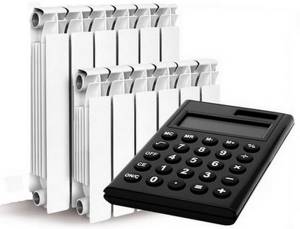
- In brick houses, 34 watts are required per 1 m3.
- In panel buildings, 41 watts are required per 1 m3.
Keeping these standards in mind, you can calculate any room. Knowing the height of the ceilings is a must.
The panel building has dimensions of 3.2 by 3.5 meters, with a ceiling height of 3 m. To determine the volume, you need to multiply 3.2, 3.5 and 3: the result is 33.6 m 3. This figure is multiplied by the coefficient for a panel house (41). The result is 1378 W. To obtain the most accurate value, use a calculation table for steel heating radiators. It displays information on each climate zone and object characteristics.
